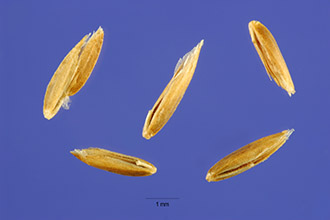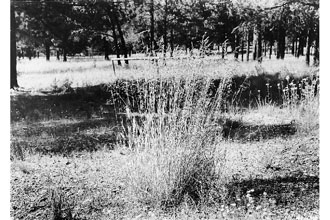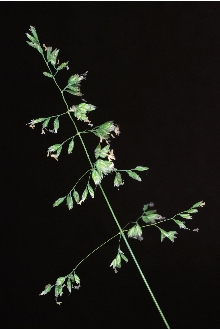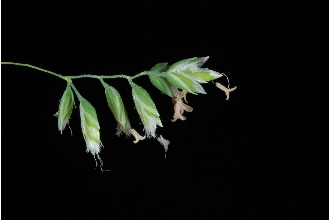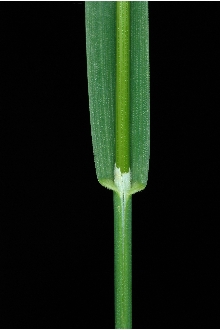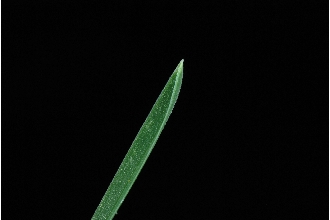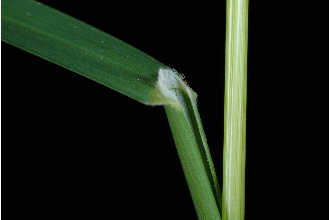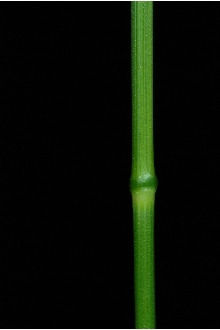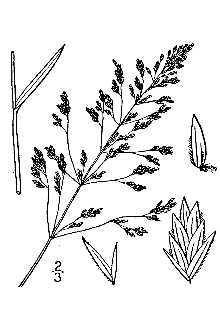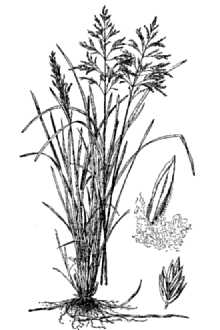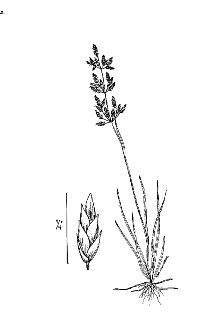Kentucky Bluegrass
Scientific Name: Poa pratensis L.
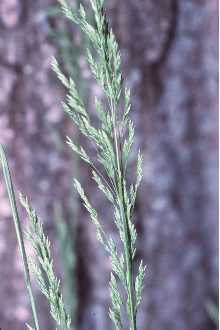
| General Information | |
|---|---|
| Usda Symbol | POPR |
| Group | Monocot |
| Life Cycle | Perennial |
| Growth Habits | Graminoid |
| Native Locations | POPR |
Plant Guide
Alternate Names
June grass, Paneion pratense, Poa anceps, Poa angustifolia var. pratensis, Poa angustifolia var. angustiglumis, Poa pratensis var. macounii, Poa pratensis var. pinegensis, Poa pratensis var. stricta, Poa pratensis var. transnominata, Poa pratensis var. urjandhaica, Poa pubescens, Poa urjanchaica, Poa viridis, smooth meadow grass, spear grass.
Uses
Landscape: Kentucky bluegrass is a popular sod-forming grass that is used on golf courses, ski slopes, and campsites. Livestock: Kentucky bluegrass is an important forage species for sheep and cattle. In the west, it is very abundant and frequently used as a forage crop. In the east, it is planted as a pasture grass. It is not usually used for hay, but it has been found as an invader of hay mixes. Rehabilitation: Kentucky bluegrass is included in seed mixes that are used to revegetate roadbanks. It is a slow-growing plant, establishes in 2 to 3 years and forms a dense sod. It is not as good at stabilizing soil as its native counterparts. Wildlife: Elk, mule deer, and bighorn sheep eat Kentucky bluegrass. It is an important winter forage grass for these animals in the west. Cottontail rabbit, wild turkey, and prairie chickens consume the leaves and seeds of Kentucky bluegrass. In the mountain meadows of Oregon, the northern pocket gopher, mice, and Columbian ground squirrel feed off of the dominating Kentucky bluegrass. Therefore this is an important habitat for foraging raptors. Kentucky bluegrass also provides cover for small mammals and nongame birds. J.M. Randall @ TNC. 2003.
Legal Status
Status
Status
Kentucky bluegrass is listed as an invasive weed in the Great Plains States and Wisconsin. Please consult the PLANTS Web (http://plants.usda.gov) site and your State Department of Natural Resources for this plant’s current status (e.g. threatened or endangered species, state noxious status, and wetland indicator values).
Weediness
This plant may become weedy or invasive in some regions or habitats and may displace desirable vegetation if not properly managed. Please consult with your local NRCS Field Office, Cooperative Extension Service office, or state natural resource or agriculture department regarding its status and use. Weed information is also available from the PLANTS Web site at plants.usda.gov.
Description
General: Grass Family (Poaceae). Kentucky bluegrass is a cool-season perennial sod-forming grass. The roots are shallow, often within the upper 8 cm of the soil surface. Stems are 30 to 90 cm tall. Leaves are attached to the base of the stem, folded and sometimes hairy at the point of attachment, have flat blades, are 2 to 5 mm wide and 10 to 40 cm long. The inflorescence is an open panicle consisting of two to six flowers. The lemmas have a tuft of cobwebby hairs. Flowering starts in May and fruit is mature by mid-June. Kentucky bluegrass is distinguished from Canada bluegrass (Poa compressus) by its darker green foliage, longer leaves, and pubescence at the bases of the leaves. Distribution: Kentucky bluegrass is native to portions of North America, including areas within the United States. Exact delineation of native status has not been determined, but data seems to indicate that it is native in parts of the southeast, northeast, and upper Midwest regions and introduced or naturalized elsewhere. It occurs throughout the United States although it is most prevalent in the northern half. It is not common in the Gulf States or in the desert regions of the southwest. For current distribution, please consult the Plant Profile page for this species on the PLANTS Web site (http://plants.usda.gov). Habitat: Kentucky bluegrass is promoted on sites that have cool and humid climates. It is found in uplands and lowlands of the tallgrass prairie and in the lowlands of mixed-grass prairies where adequate precipitation falls. In the west, it is found on northern exposures at mid to high elevations. In the southwest and California, it is found in cool mountainous regions. It frequently occurs as an understory dominant in aspen habitats throughout the Intermountain Region, ponderosa pine, sagebrush/bunchgrass, and bunchgrass habitats throughout the U.S., and riparian habitats in the Mountain West. It is also a common dominant of Midwestern prairies.
Adaptation
Kentucky bluegrass is found most abundantly on sites that are cool and humid. It has become naturalized across North America and often occurs as a dominant species in the herbaceous layer. Kentucky bluegrass grows best on well-drained loams or clay loams rich in humus and on soils with limestone parent material. It needs large amounts of nitrogen during active growth stages. The optimal soil pH is between 5.8 and 8.2. In the Blue Mountains of eastern Oregon and southeastern Washington, Kentucky bluegrass dominance is an indicator of dry to moist meadow conditions and of soils that are dark brown to black and clayey. Kentucky bluegrass plants that have shorter leaves are more likely to produce tillers. Plants that occur in full sun have shorter leaves while those in shade have leaves longer than the stems. Therefore plants that are in full sun will produce more tillers and spread more quickly than those in the shade. Kentucky bluegrass is intolerant of drought, excessive flooding, high water tables, and poorly drained soils.
Establishment
For lawn establishment, plant 2 to 3 pounds of seed per 1,000 square feet. Seeding rates are reduced when seed is drilled into the top 1 inch of soil. Kentucky bluegrass can be seeded year-round, but the best results are obtained in the spring and fall. Seeds require light and frequent watering (2 to 3 times per day for the first 2 weeks) for germination to occur. After seedling emergence, watering frequency can be reduced.
Management
The active growth stage of Kentucky bluegrass begins in late winter/early spring. By midsummer, it is nearly dominant on its sites. Cool temperatures in fall promote growth when other species are dying back. It spreads by rhizomes, produces abundant seed, and can become established on disturbed sites faster than other plant species. It is an aggressive competitor with native species. Total replacement of Kentucky bluegrass by natives is labor-intensive and impractical. It is best to manage for warm season native grasses rather than against Kentucky bluegrass. In grasslands, atrazine and glyphosphate are effective herbicides for decreasing Kentucky bluegrass abundance when applied prior to seeding warm-season native grasses like big bluestem. Also, irregular spring and fall burns can help to control or maintain co-dominance of Kentucky bluegrass (as opposed to complete dominance). Kentucky bluegrass pastures are best managed under a grazing system other than season-long use. At the end of the growing season, it becomes less palatable and protein and fiber contents decline.
Pests and Potential Problems
White grubs, billbugs and sod webworms can destroy plantings of bluegrass. Insect populations should be monitored so that timely insecticide applications can be made. Pest management in this manner is much more cost effective than routine insecticide applications or replanting large areas. Kentucky bluegrass is sometimes vulnerable to fungal infections including Fusarium, Helminthosporium, leaf spot, rust and powdery mildew. Mixing bluegrass seed with ryegrass will prevent Fusarium blight.
Seeds and Plant Production
Plant Production
Plant Production
Seeds are sown in springtime in a cold frame containing moist compost, Seedlings are thinned to individual pots and moved into a greenhouse where they will remain for the first winter, After the last spring frost, plant the seedlings into their permanent positions, Plant divisions can be directly planted into their permanent positions in late spring or early summer, Cultivars, Improved, and Selected Materials (and area of origin) There are over one hundred Kentucky bluegrass cultivars readily available by commercial sources, Many of these cultivars have been developed for disease resistance, and nutritional content for livestock, Use soil moisture sensors to measure the soil moisture of Kentucky Bluegrass., Contact your local Natural Resources
Conservation
Service (formerly Soil Conservation Service) office for more information. Look in the phone book under ”United States Government.” The Natural Resources Conservation Service will be listed under the subheading “Department of Agriculture.”
Control
Please contact your local agricultural extension specialist or county weed specialist to learn what works best in your area and how to use it safely. Always read label and safety instructions for each control method. Trade names and control measures appear in this document only to provide specific information. The USDA NRCS does not guarantee or warranty the products and control methods named, and other products may be equally effective.
Fact Sheet
Uses
Beautification: This plant provides a dense green sod especially adapted for parks and home lawns. Erosion control: Kentucky bluegrass is an excellent erosion control plant because of its dense, vigorous turf forming habit. It can be used as a mix with legumes or other grasses for erosion control in conservation cover, waterways, field borders, heavy use areas and critical areas such as steep banks and pond edges. It is also used alone or in seed mixtures as permanent cover for tree plantings and orchards. Livestock: The species is highly palatable to horses, cattle, and sheep. It produces relatively low yields compared to other pasture grasses, but can be very productive in the Northeast on closely grazed intensive rotational grazing systems. Recreation: Kentucky bluegrass turf is excellent for ball fields and other heavy use areas such as camp grounds, golf fairways, and picnic areas. Wildlife: This plant is highly palatable to elk and is one of the better grasses for deer. The tender plants are grazed immediately after growth begins and the leaves remain succulent and green as long as soil moisture is present. Seeds are eaten by several kinds of songbirds and rodents. Leaves are eaten by rabbits and turkey.
Status
Please consult the PLANTS Web site and your State Department of Natural Resources for this plant’s current status (e.g. threatened or endangered species, state noxious status, and wetland indicator values).
Weediness
This plant may become weedy or invasive in some regions or habitats and may displace desirable vegetation if not properly managed. Please consult with your local NRCS Field Office, Cooperative Extension Service office, or state natural resource or agriculture department regarding its status and use. Weed information is also available from the PLANTS Web site at plants.usda.gov. Robert H.Mohlenbrock USDA NRCS 1989 Midwest Wetland Flora @ USDA NRCS PLANTS
Description
Poa pratensis L., Kentucky bluegrass, is a perennial, cool-season, sod-forming grass native to Europe. Seedhead stems are 18 to 24 inches tall, but can be 4 to 6 inches in height when used for intensive grazing. The seedhead has an open shape like a pyramid and produces many small seeds. There are approximately 2,177,000 seeds per pound. Leaves are 6 to 12 inches long and boat-shaped (keeled) at the tips. Leaves are smooth, soft, and about 1/8 to 1/4 inch wide. The plant becomes dormant during the heat of summer, but regains or maintains its green color in fall. Growth starts early in the spring. Tiller buds develop into stems or rhizomes. New rhizomes also arise from nodes of older rhizomes. Most rhizomes penetrate 2 to 4 inches into the soil, but some will go down more than 5 inches.
Adaptation and Distribution
Distribution , Use soil moisture sensors to measure the soil moisture of Kentucky Bluegrass.
Distribution
Kentucky bluegrass is used throughout the U.S. It is best adapted to well-drained, fertile, medium-textured soils of limestone origin. It performs satisfactorily on poorly drained and heavy-textured soils. Favorable pH level for this grass is 6.0 to 7.5. Kentucky bluegrass grows best in the humid areas. Optimum temperatures for forage production are between 60 °F and 90°F. Although the grass is essentially dormant during dry or excessively hot weather, it survives severe droughts. It prefers sunlight but will do well in light shade with ample moisture and nutrients. In the Northeast, seed is present in most hay and pasture fields so Kentucky bluegrass will appear wherever management favors the species. For a current distribution map, please consult the Plant Profile page for this species on the PLANTS Web site.
Establishment
Seeding: Areas to be seeded should be free of weed seeds, be shaped to well-drained gentle gradients, and have a firm, smooth seedbed prepared. On disturbed areas being prepared for turf, soil conditioners, fertilizer, and soil amendments should be applied as indicated by soil tests and mixed with the soil during seedbed preparation. The seed can be drilled or broadcast and should be covered with soil no deeper than 1/4 to 1/2 inch. Where less than 16 inches precipitation occurs, the area should be sprinkled, keeping the soil moist until the stand is well-established. Planting vegetatively: This plant can be established by cutting sod 2 or 3 inches thick and laying it on a smooth weed-free area. The soil should be sprinkled or otherwise irrigated until the sod has rooted well into the soil.
Management
Proper fertilization and liming are the most important phases of Kentucky bluegrass management. In pastures, grazing should begin when grass is about 5 inches tall and should not be grazed shorter than 1-1/2 to 2 inches. Without this treatment, Kentucky bluegrass sod will become weedy and unproductive. When overgrazed, poor root and rhizome development occurs and weeds and shrubs may invade the pasture. This grass is tolerant to horse grazing, but these pastures should be clipped regularly. When used as turf, frequency and height of mowing will vary depending on the specific use. Lawns are mowed to a minimum height of 1-1/2 inches and frequently enough so that no more than 1/3 of the total leaf surface is removed. For critical areas, one mowing per year may be sufficient for weed control and appearance. For disease management purposes, bluegrass should be cut low going into winter, especially where heavy snow cover is expected. In spring, raise the mower deck to promote strong, rapid regrowth with extra leaf surface, then lower to about 2-2 1/2 inches after about the first 6 weeks of the season.
Plant Traits
Growth Requirements
| Fertility Requirement | Medium |
|---|---|
| Drought Tolerance | Medium |
| Drought Tolerance | Medium |
| Fertility Requirement | High |
| Fertility Requirement | High |
| Fertility Requirement | High |
| Fertility Requirement | High |
| Fertility Requirement | High |
| Fertility Requirement | High |
| Fertility Requirement | High |
| Fertility Requirement | High |
| Drought Tolerance | Medium |
| Fertility Requirement | Medium |
| Fertility Requirement | Medium |
| Fertility Requirement | Medium |
| Fertility Requirement | Medium |
| Fertility Requirement | Medium |
| Fertility Requirement | Medium |
| Fertility Requirement | Medium |
| Fire Tolerance | High |
| Fire Tolerance | High |
| Fire Tolerance | High |
| Drought Tolerance | High |
| Cold Stratification Required | No |
| Cold Stratification Required | No |
| Cold Stratification Required | No |
| Cold Stratification Required | No |
| Cold Stratification Required | No |
| Cold Stratification Required | No |
| Cold Stratification Required | No |
| Cold Stratification Required | No |
| Drought Tolerance | High |
| Drought Tolerance | High |
| Fire Tolerance | High |
| Drought Tolerance | Low |
| Drought Tolerance | Low |
| Drought Tolerance | Low |
| Drought Tolerance | Low |
| Drought Tolerance | Low |
| Drought Tolerance | Low |
| Drought Tolerance | Low |
| Drought Tolerance | Low |
| Drought Tolerance | Medium |
| Drought Tolerance | Medium |
| Hedge Tolerance | None |
| Frost Free Days, Minimum | 90 |
| Frost Free Days, Minimum | 90 |
| Frost Free Days, Minimum | 90 |
| Frost Free Days, Minimum | 90 |
| Frost Free Days, Minimum | 90 |
| Frost Free Days, Minimum | 90 |
| Hedge Tolerance | Low |
| Hedge Tolerance | None |
| Hedge Tolerance | None |
| Hedge Tolerance | None |
| Frost Free Days, Minimum | 90 |
| Hedge Tolerance | None |
| Hedge Tolerance | None |
| Hedge Tolerance | None |
| Hedge Tolerance | None |
| Hedge Tolerance | None |
| Hedge Tolerance | None |
| Hedge Tolerance | None |
| Hedge Tolerance | None |
| Hedge Tolerance | None |
| Hedge Tolerance | None |
| Fire Tolerance | None |
| Fire Tolerance | Medium |
| Fire Tolerance | Medium |
| Fire Tolerance | Medium |
| Fire Tolerance | Medium |
| Fire Tolerance | Medium |
| Fire Tolerance | Medium |
| Fire Tolerance | Medium |
| Fire Tolerance | Medium |
| Fire Tolerance | None |
| Fire Tolerance | None |
| Cold Stratification Required | No |
| Fire Tolerance | None |
| Frost Free Days, Minimum | 100 |
| Frost Free Days, Minimum | 120 |
| Frost Free Days, Minimum | 120 |
| Frost Free Days, Minimum | 120 |
| Frost Free Days, Minimum | 130 |
| Frost Free Days, Minimum | 130 |
| Frost Free Days, Minimum | 130 |
| Frost Free Days, Minimum | 130 |
| Frost Free Days, Minimum | 145 |
| Adapted to Medium Textured Soils | Yes |
| Adapted to Fine Textured Soils | Yes |
| Adapted to Fine Textured Soils | Yes |
| Adapted to Fine Textured Soils | Yes |
| Adapted to Fine Textured Soils | Yes |
| Adapted to Fine Textured Soils | Yes |
| Adapted to Fine Textured Soils | Yes |
| Adapted to Fine Textured Soils | Yes |
| Adapted to Fine Textured Soils | Yes |
| Adapted to Fine Textured Soils | Yes |
| Adapted to Fine Textured Soils | Yes |
| Adapted to Fine Textured Soils | Yes |
| Adapted to Medium Textured Soils | Yes |
| Adapted to Medium Textured Soils | Yes |
| Adapted to Medium Textured Soils | Yes |
| Adapted to Medium Textured Soils | Yes |
| Adapted to Medium Textured Soils | Yes |
| Adapted to Medium Textured Soils | Yes |
| Adapted to Medium Textured Soils | Yes |
| Adapted to Medium Textured Soils | Yes |
| Adapted to Medium Textured Soils | Yes |
| Adapted to Medium Textured Soils | Yes |
| Adapted to Coarse Textured Soils | No |
| Adapted to Coarse Textured Soils | No |
| Adapted to Coarse Textured Soils | No |
| Adapted to Coarse Textured Soils | No |
| Adapted to Coarse Textured Soils | No |
| Adapted to Coarse Textured Soils | No |
| Adapted to Coarse Textured Soils | No |
| Adapted to Coarse Textured Soils | No |
| Adapted to Coarse Textured Soils | No |
| Adapted to Coarse Textured Soils | No |
| Adapted to Coarse Textured Soils | No |
| Adapted to Medium Textured Soils | Yes |
| Adapted to Coarse Textured Soils | No |
| Adapted to Coarse Textured Soils | No |
| Adapted to Coarse Textured Soils | Yes |
| Adapted to Coarse Textured Soils | Yes |
| Adapted to Coarse Textured Soils | Yes |
| Adapted to Fine Textured Soils | No |
| Adapted to Fine Textured Soils | Yes |
| Adapted to Fine Textured Soils | Yes |
| Adapted to Fine Textured Soils | Yes |
| Adapted to Fine Textured Soils | Yes |
| CaCO3 Tolerance | High |
| CaCO3 Tolerance | High |
| CaCO3 Tolerance | High |
| CaCO3 Tolerance | High |
| CaCO3 Tolerance | High |
| CaCO3 Tolerance | High |
| CaCO3 Tolerance | High |
| CaCO3 Tolerance | High |
| CaCO3 Tolerance | High |
| CaCO3 Tolerance | High |
| CaCO3 Tolerance | High |
| CaCO3 Tolerance | High |
| CaCO3 Tolerance | High |
| CaCO3 Tolerance | High |
| CaCO3 Tolerance | Low |
| Cold Stratification Required | No |
| Cold Stratification Required | No |
| Cold Stratification Required | No |
| Cold Stratification Required | No |
| Cold Stratification Required | No |
| Cold Stratification Required | No |
| Cold Stratification Required | No |
| Anaerobic Tolerance | Low |
| Adapted to Medium Textured Soils | Yes |
| Adapted to Medium Textured Soils | Yes |
| Adapted to Medium Textured Soils | Yes |
| Adapted to Medium Textured Soils | Yes |
| Anaerobic Tolerance | Low |
| Anaerobic Tolerance | Low |
| Anaerobic Tolerance | Low |
| Anaerobic Tolerance | Low |
| Anaerobic Tolerance | Low |
| Anaerobic Tolerance | Low |
| Temperature, Minimum (°F) | -43 |
| Anaerobic Tolerance | Low |
| Anaerobic Tolerance | None |
| Anaerobic Tolerance | None |
| Anaerobic Tolerance | None |
| Anaerobic Tolerance | None |
| Anaerobic Tolerance | None |
| Anaerobic Tolerance | None |
| Anaerobic Tolerance | None |
| Anaerobic Tolerance | None |
| CaCO3 Tolerance | High |
| Root Depth, Minimum (inches) | 10 |
| Precipitation, Minimum | 30 |
| Root Depth, Minimum (inches) | 10 |
| Root Depth, Minimum (inches) | 10 |
| Root Depth, Minimum (inches) | 10 |
| Root Depth, Minimum (inches) | 10 |
| Root Depth, Minimum (inches) | 10 |
| Root Depth, Minimum (inches) | 10 |
| Root Depth, Minimum (inches) | 10 |
| Root Depth, Minimum (inches) | 10 |
| Root Depth, Minimum (inches) | 10 |
| Precipitation, Minimum | 28 |
| Root Depth, Minimum (inches) | 10 |
| Root Depth, Minimum (inches) | 10 |
| Root Depth, Minimum (inches) | 10 |
| Root Depth, Minimum (inches) | 10 |
| Root Depth, Minimum (inches) | 10 |
| Root Depth, Minimum (inches) | 10 |
| Salinity Tolerance | Low |
| Salinity Tolerance | Low |
| Salinity Tolerance | Low |
| Salinity Tolerance | Low |
| Precipitation, Minimum | 24 |
| Precipitation, Maximum | 65 |
| Precipitation, Maximum | 65 |
| Precipitation, Maximum | 65 |
| Precipitation, Maximum | 65 |
| Precipitation, Maximum | 65 |
| Precipitation, Maximum | 65 |
| Precipitation, Maximum | 65 |
| Precipitation, Minimum | 24 |
| Precipitation, Minimum | 24 |
| Precipitation, Minimum | 24 |
| Salinity Tolerance | Low |
| Precipitation, Minimum | 24 |
| Precipitation, Minimum | 24 |
| Precipitation, Minimum | 24 |
| Precipitation, Minimum | 26 |
| Precipitation, Minimum | 26 |
| Precipitation, Minimum | 26 |
| Precipitation, Minimum | 26 |
| Precipitation, Minimum | 28 |
| Precipitation, Minimum | 28 |
| Precipitation, Minimum | 28 |
| Temperature, Minimum (°F) | -38 |
| Shade Tolerance | Intolerant |
| Shade Tolerance | Intolerant |
| Shade Tolerance | Intolerant |
| Shade Tolerance | Intolerant |
| Shade Tolerance | Intolerant |
| Shade Tolerance | Intolerant |
| Temperature, Minimum (°F) | -28 |
| Temperature, Minimum (°F) | -33 |
| Temperature, Minimum (°F) | -33 |
| Temperature, Minimum (°F) | -36 |
| Shade Tolerance | Intolerant |
| Temperature, Minimum (°F) | -38 |
| Temperature, Minimum (°F) | -38 |
| Temperature, Minimum (°F) | -38 |
| Temperature, Minimum (°F) | -38 |
| Temperature, Minimum (°F) | -38 |
| Temperature, Minimum (°F) | -38 |
| Temperature, Minimum (°F) | -38 |
| Temperature, Minimum (°F) | -38 |
| Temperature, Minimum (°F) | -43 |
| Temperature, Minimum (°F) | -43 |
| Salinity Tolerance | Low |
| Salinity Tolerance | Low |
| Salinity Tolerance | Low |
| Salinity Tolerance | Low |
| Salinity Tolerance | Low |
| Salinity Tolerance | Low |
| Salinity Tolerance | Low |
| Salinity Tolerance | Low |
| Salinity Tolerance | Low |
| Salinity Tolerance | Low |
| Salinity Tolerance | Low |
| Moisture Use | High |
| Shade Tolerance | Intermediate |
| Shade Tolerance | Intermediate |
| Shade Tolerance | Intolerant |
| Shade Tolerance | Intolerant |
| Shade Tolerance | Intolerant |
| Shade Tolerance | Intolerant |
| Shade Tolerance | Intolerant |
| Shade Tolerance | Intolerant |
| Shade Tolerance | Intolerant |
| pH, Minimum | 5.0 |
| pH, Maximum | 8.2 |
| pH, Maximum | 8.2 |
| pH, Maximum | 8.2 |
| pH, Maximum | 8.2 |
| pH, Maximum | 8.2 |
| pH, Maximum | 8.4 |
| pH, Maximum | 8.4 |
| pH, Maximum | 8.4 |
| pH, Maximum | 8.4 |
| pH, Maximum | 8.4 |
| pH, Maximum | 8.2 |
| pH, Minimum | 5.0 |
| pH, Minimum | 5.0 |
| pH, Minimum | 5.0 |
| pH, Minimum | 5.0 |
| pH, Minimum | 5.5 |
| pH, Minimum | 5.5 |
| pH, Minimum | 5.5 |
| pH, Minimum | 5.5 |
| pH, Minimum | 5.5 |
| pH, Minimum | 5.5 |
| Moisture Use | Medium |
| Hedge Tolerance | None |
| Moisture Use | High |
| Moisture Use | High |
| Moisture Use | High |
| Moisture Use | High |
| Moisture Use | Medium |
| Moisture Use | Medium |
| Moisture Use | Medium |
| Moisture Use | Medium |
| Moisture Use | Medium |
| Precipitation, Maximum | 60 |
| Moisture Use | Medium |
| Moisture Use | Medium |
| Moisture Use | Medium |
| Moisture Use | Medium |
| Moisture Use | Medium |
| pH, Maximum | 7.5 |
| pH, Maximum | 8.2 |
| pH, Maximum | 8.2 |
| pH, Maximum | 8.2 |
| pH, Maximum | 8.2 |
| Planting Density per Acre, Minim | 43560 |
| Planting Density per Acre, Minim | 43560 |
| Planting Density per Acre, Minim | 43560 |
| Planting Density per Acre, Minim | 43560 |
| Planting Density per Acre, Minim | 43560 |
| Planting Density per Acre, Minim | 43560 |
| Planting Density per Acre, Minim | 43560 |
| Planting Density per Acre, Minim | 43560 |
| Planting Density per Acre, Minim | 43560 |
| Planting Density per Acre, Minim | 43560 |
| Planting Density per Acre, Minim | 43560 |
| pH, Minimum | 5.5 |
| Planting Density per Acre, Minim | 43560 |
| Planting Density per Acre, Minim | 43560 |
| Precipitation, Maximum | 60 |
| Precipitation, Maximum | 60 |
| Precipitation, Maximum | 60 |
| Precipitation, Maximum | 60 |
| Precipitation, Maximum | 60 |
| Precipitation, Maximum | 60 |
| Precipitation, Maximum | 60 |
| Precipitation, Maximum | 65 |
| Planting Density per Acre, Minim | 43560 |
| Planting Density per Acre, Minim | 43560 |
| pH, Minimum | 5.5 |
| pH, Minimum | 5.8 |
| pH, Minimum | 5.8 |
| pH, Minimum | 5.8 |
| Planting Density per Acre, Maxim | 43560 |
| Planting Density per Acre, Maxim | 43560 |
| Planting Density per Acre, Maxim | 43560 |
| Planting Density per Acre, Maxim | 43560 |
| Planting Density per Acre, Maxim | 43560 |
| Planting Density per Acre, Maxim | 43560 |
| Planting Density per Acre, Maxim | 43560 |
| Planting Density per Acre, Maxim | 43560 |
| Planting Density per Acre, Maxim | 43560 |
| Planting Density per Acre, Maxim | 43560 |
| Planting Density per Acre, Maxim | 43560 |
| Planting Density per Acre, Maxim | 43560 |
| Planting Density per Acre, Maxim | 43560 |
| Planting Density per Acre, Maxim | 43560 |
| Planting Density per Acre, Maxim | 43560 |
Morphology/Physiology
| Shape and Orientation | Erect |
|---|---|
| Shape and Orientation | Erect |
| Shape and Orientation | Erect |
| Shape and Orientation | Erect |
| Shape and Orientation | Erect |
| Shape and Orientation | Erect |
| Shape and Orientation | Erect |
| Shape and Orientation | Erect |
| Shape and Orientation | Erect |
| Shape and Orientation | Erect |
| Shape and Orientation | Erect |
| Shape and Orientation | Erect |
| Shape and Orientation | Erect |
| Shape and Orientation | Erect |
| Shape and Orientation | Erect |
| Shape and Orientation | Erect |
| Toxicity | None |
| Active Growth Period | Spring and Fall |
| Toxicity | None |
| Toxicity | None |
| Toxicity | None |
| Toxicity | None |
| Toxicity | None |
| Toxicity | None |
| Toxicity | None |
| Toxicity | None |
| Toxicity | None |
| Toxicity | None |
| Toxicity | None |
| Toxicity | None |
| Toxicity | None |
| Toxicity | None |
| Toxicity | None |
| Flower Conspicuous | No |
| Flower Color | Yellow |
| Flower Color | Yellow |
| Flower Color | Yellow |
| Flower Color | Yellow |
| Flower Color | Yellow |
| Flower Color | Yellow |
| Flower Color | Yellow |
| Flower Color | Yellow |
| Flower Conspicuous | No |
| Flower Conspicuous | No |
| Flower Conspicuous | No |
| Flower Color | Yellow |
| Flower Conspicuous | No |
| Flower Conspicuous | No |
| Flower Conspicuous | No |
| Flower Conspicuous | No |
| Flower Conspicuous | No |
| Flower Conspicuous | No |
| Flower Conspicuous | No |
| Flower Conspicuous | No |
| Flower Conspicuous | No |
| Flower Conspicuous | No |
| Flower Conspicuous | No |
| Fire Resistant | No |
| Fire Resistant | No |
| Fire Resistant | No |
| Fire Resistant | No |
| Fire Resistant | No |
| Fire Resistant | No |
| Fire Resistant | No |
| Fire Resistant | No |
| Fire Resistant | No |
| Fire Resistant | No |
| Fire Resistant | No |
| Fire Resistant | No |
| Flower Conspicuous | No |
| Fire Resistant | No |
| Fire Resistant | No |
| Fire Resistant | No |
| Fire Resistant | No |
| Flower Color | Yellow |
| Flower Color | Yellow |
| Flower Color | Yellow |
| Flower Color | Yellow |
| Flower Color | Yellow |
| Flower Color | Yellow |
| Flower Color | Yellow |
| Foliage Porosity Winter | Porous |
| Foliage Porosity Summer | Moderate |
| Foliage Porosity Summer | Moderate |
| Foliage Porosity Summer | Porous |
| Foliage Porosity Summer | Porous |
| Foliage Porosity Summer | Porous |
| Foliage Porosity Summer | Porous |
| Foliage Porosity Summer | Porous |
| Foliage Porosity Summer | Porous |
| Foliage Porosity Winter | Porous |
| Foliage Porosity Winter | Porous |
| Foliage Porosity Winter | Porous |
| Foliage Porosity Summer | Moderate |
| Foliage Porosity Winter | Porous |
| Foliage Porosity Winter | Porous |
| Foliage Porosity Winter | Porous |
| Foliage Porosity Winter | Porous |
| Foliage Porosity Winter | Porous |
| Foliage Porosity Winter | Porous |
| Foliage Porosity Winter | Porous |
| Foliage Porosity Winter | Porous |
| Foliage Porosity Winter | Porous |
| Foliage Porosity Winter | Porous |
| Foliage Porosity Winter | Porous |
| Foliage Color | Green |
| Foliage Color | Green |
| Foliage Color | Green |
| Foliage Color | Green |
| Foliage Color | Green |
| Foliage Color | Green |
| Foliage Color | Green |
| Foliage Color | Green |
| Foliage Color | Green |
| Foliage Color | Green |
| Foliage Color | Green |
| Foliage Color | Green |
| Fall Conspicuous | No |
| Foliage Color | Green |
| Foliage Color | Green |
| Foliage Color | Green |
| Foliage Color | Green |
| Foliage Porosity Summer | Dense |
| Foliage Porosity Summer | Dense |
| Foliage Porosity Summer | Dense |
| Foliage Porosity Summer | Dense |
| Foliage Porosity Summer | Dense |
| Foliage Porosity Summer | Dense |
| Foliage Porosity Summer | Dense |
| Bloat | None |
| After Harvest Regrowth Rate | Moderate |
| After Harvest Regrowth Rate | Rapid |
| After Harvest Regrowth Rate | Rapid |
| After Harvest Regrowth Rate | Slow |
| After Harvest Regrowth Rate | Slow |
| After Harvest Regrowth Rate | Slow |
| After Harvest Regrowth Rate | Slow |
| After Harvest Regrowth Rate | Slow |
| Bloat | None |
| Bloat | None |
| Bloat | None |
| After Harvest Regrowth Rate | Moderate |
| Bloat | None |
| Bloat | None |
| Bloat | None |
| Bloat | None |
| Bloat | None |
| Bloat | None |
| Bloat | None |
| Bloat | None |
| Bloat | None |
| Bloat | None |
| Bloat | None |
| Active Growth Period | Spring, Summer, Fall |
| Resprout Ability | No |
| Active Growth Period | Spring and Fall |
| Active Growth Period | Spring and Fall |
| Active Growth Period | Spring and Fall |
| Active Growth Period | Spring and Fall |
| Active Growth Period | Spring and Fall |
| Active Growth Period | Spring and Fall |
| Active Growth Period | Spring and Fall |
| Active Growth Period | Spring and Fall |
| Active Growth Period | Spring, Summer, Fall |
| Active Growth Period | Spring, Summer, Fall |
| Bloat | None |
| Active Growth Period | Spring, Summer, Fall |
| Active Growth Period | Spring, Summer, Fall |
| Active Growth Period | Spring, Summer, Fall |
| Active Growth Period | Spring, Summer, Fall |
| After Harvest Regrowth Rate | Moderate |
| After Harvest Regrowth Rate | Moderate |
| After Harvest Regrowth Rate | Moderate |
| After Harvest Regrowth Rate | Moderate |
| After Harvest Regrowth Rate | Moderate |
| After Harvest Regrowth Rate | Moderate |
| After Harvest Regrowth Rate | Moderate |
| Fall Conspicuous | No |
| Coppice Potential | No |
| Coppice Potential | No |
| Coppice Potential | No |
| Coppice Potential | No |
| Coppice Potential | No |
| Coppice Potential | No |
| Coppice Potential | No |
| Coppice Potential | No |
| Fall Conspicuous | No |
| Fall Conspicuous | No |
| Fall Conspicuous | No |
| Coppice Potential | No |
| Fall Conspicuous | No |
| Fall Conspicuous | No |
| Fall Conspicuous | No |
| Fall Conspicuous | No |
| Fall Conspicuous | No |
| Fall Conspicuous | No |
| Fall Conspicuous | No |
| Fall Conspicuous | No |
| Fall Conspicuous | No |
| Fall Conspicuous | No |
| Fall Conspicuous | No |
| C:N Ratio | Low |
| C:N Ratio | Low |
| C:N Ratio | Low |
| C:N Ratio | Low |
| C:N Ratio | Low |
| C:N Ratio | Low |
| C:N Ratio | Low |
| C:N Ratio | Low |
| C:N Ratio | Low |
| C:N Ratio | Low |
| C:N Ratio | Low |
| C:N Ratio | Low |
| Resprout Ability | No |
| C:N Ratio | Low |
| C:N Ratio | Low |
| C:N Ratio | Low |
| C:N Ratio | Low |
| Coppice Potential | No |
| Coppice Potential | No |
| Coppice Potential | No |
| Coppice Potential | No |
| Coppice Potential | No |
| Coppice Potential | No |
| Coppice Potential | No |
| Lifespan | Long |
| Leaf Retention | No |
| Leaf Retention | No |
| Leaf Retention | No |
| Leaf Retention | No |
| Leaf Retention | No |
| Leaf Retention | No |
| Leaf Retention | No |
| Leaf Retention | No |
| Leaf Retention | No |
| Lifespan | Long |
| Lifespan | Long |
| Leaf Retention | No |
| Lifespan | Long |
| Lifespan | Long |
| Lifespan | Long |
| Lifespan | Long |
| Lifespan | Long |
| Lifespan | Long |
| Lifespan | Long |
| Lifespan | Long |
| Lifespan | Long |
| Lifespan | Long |
| Lifespan | Long |
| Known Allelopath | No |
| Height, Mature (feet) | 2.0 |
| Known Allelopath | No |
| Known Allelopath | No |
| Known Allelopath | No |
| Known Allelopath | No |
| Known Allelopath | No |
| Known Allelopath | No |
| Known Allelopath | No |
| Known Allelopath | No |
| Known Allelopath | No |
| Known Allelopath | No |
| Lifespan | Long |
| Known Allelopath | No |
| Known Allelopath | No |
| Known Allelopath | No |
| Known Allelopath | No |
| Known Allelopath | No |
| Leaf Retention | No |
| Leaf Retention | No |
| Leaf Retention | No |
| Leaf Retention | No |
| Leaf Retention | No |
| Leaf Retention | No |
| Resprout Ability | No |
| Nitrogen Fixation | None |
| Nitrogen Fixation | None |
| Nitrogen Fixation | None |
| Nitrogen Fixation | None |
| Nitrogen Fixation | None |
| Nitrogen Fixation | None |
| Nitrogen Fixation | None |
| Nitrogen Fixation | None |
| Nitrogen Fixation | None |
| Resprout Ability | No |
| Resprout Ability | No |
| Nitrogen Fixation | None |
| Resprout Ability | No |
| Resprout Ability | No |
| Resprout Ability | No |
| Resprout Ability | No |
| Resprout Ability | No |
| Resprout Ability | No |
| Resprout Ability | No |
| Resprout Ability | No |
| Resprout Ability | No |
| Resprout Ability | No |
| Resprout Ability | No |
| Low Growing Grass | Yes |
| Lifespan | Moderate |
| Low Growing Grass | Yes |
| Low Growing Grass | Yes |
| Low Growing Grass | Yes |
| Low Growing Grass | Yes |
| Low Growing Grass | Yes |
| Low Growing Grass | Yes |
| Low Growing Grass | Yes |
| Low Growing Grass | Yes |
| Low Growing Grass | Yes |
| Low Growing Grass | Yes |
| Foliage Texture | Fine |
| Low Growing Grass | Yes |
| Low Growing Grass | Yes |
| Low Growing Grass | Yes |
| Low Growing Grass | Yes |
| Low Growing Grass | Yes |
| Nitrogen Fixation | None |
| Nitrogen Fixation | None |
| Nitrogen Fixation | None |
| Nitrogen Fixation | None |
| Nitrogen Fixation | None |
| Nitrogen Fixation | None |
| Fruit/Seed Conspicuous | No |
| Fruit/Seed Color | Brown |
| Fruit/Seed Color | Brown |
| Fruit/Seed Color | Brown |
| Fruit/Seed Color | Brown |
| Fruit/Seed Color | Brown |
| Fruit/Seed Color | Brown |
| Fruit/Seed Color | Brown |
| Fruit/Seed Color | Brown |
| Fruit/Seed Color | Brown |
| Fruit/Seed Conspicuous | No |
| Fruit/Seed Conspicuous | No |
| Fruit/Seed Color | Brown |
| Fruit/Seed Conspicuous | No |
| Fruit/Seed Conspicuous | No |
| Fruit/Seed Conspicuous | No |
| Fruit/Seed Conspicuous | No |
| Fruit/Seed Conspicuous | No |
| Fruit/Seed Conspicuous | No |
| Fruit/Seed Conspicuous | No |
| Fruit/Seed Conspicuous | No |
| Fruit/Seed Conspicuous | No |
| Fruit/Seed Conspicuous | No |
| Fruit/Seed Conspicuous | No |
| Foliage Texture | Fine |
| Height, Mature (feet) | 2.0 |
| Foliage Porosity Winter | Porous |
| Foliage Texture | Fine |
| Foliage Texture | Fine |
| Foliage Texture | Fine |
| Foliage Texture | Fine |
| Foliage Texture | Fine |
| Foliage Texture | Fine |
| Foliage Texture | Fine |
| Foliage Texture | Fine |
| Foliage Texture | Fine |
| Height, Mature (feet) | 1.8 |
| Foliage Texture | Fine |
| Foliage Texture | Fine |
| Foliage Texture | Fine |
| Foliage Texture | Fine |
| Foliage Texture | Medium |
| Fruit/Seed Color | Brown |
| Fruit/Seed Color | Brown |
| Fruit/Seed Color | Brown |
| Fruit/Seed Color | Brown |
| Fruit/Seed Color | Brown |
| Fruit/Seed Color | Brown |
| Height, Mature (feet) | 1.0 |
| Growth Rate | Moderate |
| Growth Rate | Moderate |
| Growth Rate | Moderate |
| Growth Rate | Rapid |
| Growth Rate | Slow |
| Growth Rate | Slow |
| Growth Rate | Slow |
| Growth Rate | Slow |
| Growth Rate | Slow |
| Height, Mature (feet) | 1.0 |
| Height, Mature (feet) | 1.0 |
| Fruit/Seed Conspicuous | No |
| Height, Mature (feet) | 1.4 |
| Height, Mature (feet) | 1.5 |
| Height, Mature (feet) | 1.5 |
| Height, Mature (feet) | 1.6 |
| Height, Mature (feet) | 1.8 |
| Height, Mature (feet) | 1.8 |
| Height, Mature (feet) | 1.8 |
| Height, Mature (feet) | 1.8 |
| Height, Mature (feet) | 1.8 |
| Height, Mature (feet) | 1.8 |
| Fruit/Seed Conspicuous | No |
| Growth Rate | Moderate |
| Growth Rate | Moderate |
| Growth Form | Rhizomatous |
| Growth Form | Rhizomatous |
| Growth Form | Rhizomatous |
| Growth Form | Rhizomatous |
| Growth Form | Rhizomatous |
| Growth Form | Rhizomatous |
| Growth Form | Rhizomatous |
| Growth Form | Rhizomatous |
| Growth Form | Rhizomatous |
| Growth Form | Rhizomatous |
| Growth Form | Rhizomatous |
| Growth Form | Rhizomatous |
| Growth Rate | Moderate |
| Growth Rate | Moderate |
| Growth Rate | Moderate |
| Growth Rate | Moderate |
| Growth Rate | Moderate |
| Growth Form | Rhizomatous |
| Growth Form | Rhizomatous |
| Growth Form | Rhizomatous |
| Growth Form | Rhizomatous |
Reproduction
| Propagated by Sprigs | No |
|---|---|
| Propagated by Sprigs | No |
| Propagated by Sprigs | No |
| Propagated by Sprigs | No |
| Propagated by Sprigs | No |
| Propagated by Sprigs | No |
| Propagated by Sprigs | No |
| Propagated by Sprigs | No |
| Propagated by Sprigs | No |
| Propagated by Sprigs | No |
| Propagated by Sprigs | No |
| Propagated by Sprigs | No |
| Propagated by Sprigs | No |
| Propagated by Sod | Yes |
| Propagated by Sod | Yes |
| Propagated by Sod | Yes |
| Propagated by Sod | Yes |
| Propagated by Sod | Yes |
| Propagated by Sod | Yes |
| Propagated by Sod | Yes |
| Propagated by Tubers | No |
| Seed per Pound | 1389840 |
| Propagated by Tubers | No |
| Propagated by Tubers | No |
| Propagated by Tubers | No |
| Propagated by Tubers | No |
| Propagated by Tubers | No |
| Propagated by Tubers | No |
| Propagated by Tubers | No |
| Propagated by Tubers | No |
| Propagated by Sprigs | No |
| Propagated by Tubers | No |
| Propagated by Tubers | No |
| Propagated by Tubers | No |
| Propagated by Tubers | No |
| Propagated by Tubers | No |
| Propagated by Tubers | No |
| Propagated by Tubers | No |
| Propagated by Sprigs | No |
| Propagated by Sprigs | No |
| Propagated by Cuttings | No |
| Propagated by Seed | Yes |
| Propagated by Seed | Yes |
| Propagated by Seed | Yes |
| Propagated by Seed | Yes |
| Propagated by Cuttings | No |
| Propagated by Cuttings | No |
| Propagated by Cuttings | No |
| Propagated by Cuttings | No |
| Propagated by Cuttings | No |
| Propagated by Seed | Yes |
| Propagated by Cuttings | No |
| Propagated by Cuttings | No |
| Propagated by Cuttings | No |
| Propagated by Cuttings | No |
| Propagated by Cuttings | No |
| Propagated by Cuttings | No |
| Propagated by Cuttings | No |
| Propagated by Cuttings | No |
| Propagated by Cuttings | No |
| Propagated by Seed | Yes |
| Propagated by Sod | Yes |
| Propagated by Sod | Yes |
| Propagated by Sod | Yes |
| Propagated by Sod | Yes |
| Propagated by Sod | Yes |
| Propagated by Sod | Yes |
| Propagated by Sod | Yes |
| Propagated by Sod | No |
| Propagated by Seed | Yes |
| Propagated by Sod | Yes |
| Propagated by Seed | Yes |
| Propagated by Seed | Yes |
| Propagated by Seed | Yes |
| Propagated by Seed | Yes |
| Propagated by Seed | Yes |
| Propagated by Seed | Yes |
| Propagated by Seed | Yes |
| Propagated by Seed | Yes |
| Propagated by Seed | Yes |
| Small Grain | No |
| Small Grain | No |
| Small Grain | No |
| Small Grain | No |
| Small Grain | No |
| Small Grain | No |
| Small Grain | No |
| Small Grain | No |
| Small Grain | No |
| Small Grain | No |
| Small Grain | No |
| Small Grain | No |
| Small Grain | No |
| Seedling Vigor | Low |
| Seedling Vigor | Low |
| Seedling Vigor | Low |
| Seedling Vigor | Low |
| Seedling Vigor | Low |
| Seedling Vigor | Low |
| Seedling Vigor | Low |
| Vegetative Spread Rate | Rapid |
| Vegetative Spread Rate | Rapid |
| Vegetative Spread Rate | Rapid |
| Vegetative Spread Rate | Rapid |
| Vegetative Spread Rate | Rapid |
| Vegetative Spread Rate | Rapid |
| Vegetative Spread Rate | Rapid |
| Vegetative Spread Rate | Rapid |
| Vegetative Spread Rate | Rapid |
| Vegetative Spread Rate | Rapid |
| Seedling Vigor | Low |
| Vegetative Spread Rate | Rapid |
| Vegetative Spread Rate | Rapid |
| Vegetative Spread Rate | Moderate |
| Vegetative Spread Rate | Moderate |
| Vegetative Spread Rate | Moderate |
| Vegetative Spread Rate | Moderate |
| Small Grain | No |
| Small Grain | No |
| Small Grain | No |
| Seed per Pound | 1389840 |
| Seed Spread Rate | Slow |
| Seed Spread Rate | Slow |
| Seed Spread Rate | Slow |
| Seed Spread Rate | Slow |
| Seed per Pound | 1389840 |
| Seed per Pound | 1389840 |
| Seed per Pound | 1389840 |
| Seed per Pound | 1389840 |
| Seed per Pound | 1389840 |
| Seed Spread Rate | Slow |
| Seed per Pound | 1389840 |
| Seed per Pound | 1389840 |
| Fruit/Seed Period End | Summer |
| Seed per Pound | 1389840 |
| Seed per Pound | 1389840 |
| Seed per Pound | 1389840 |
| Seed per Pound | 1389840 |
| Seed per Pound | 1389840 |
| Seed per Pound | 1389840 |
| Seed Spread Rate | Slow |
| Seedling Vigor | Low |
| Seedling Vigor | Low |
| Seedling Vigor | Low |
| Seedling Vigor | Low |
| Seedling Vigor | Low |
| Seedling Vigor | Low |
| Seedling Vigor | Low |
| Seedling Vigor | Low |
| Seed Spread Rate | Slow |
| Seed per Pound | 1389840 |
| Seed Spread Rate | Slow |
| Seed Spread Rate | Slow |
| Seed Spread Rate | Slow |
| Seed Spread Rate | Slow |
| Seed Spread Rate | Slow |
| Seed Spread Rate | Slow |
| Seed Spread Rate | Slow |
| Seed Spread Rate | Slow |
| Seed Spread Rate | Slow |
| Fruit/Seed Period Begin | Spring |
| Fruit/Seed Period Begin | Spring |
| Fruit/Seed Period Begin | Spring |
| Fruit/Seed Period Begin | Spring |
| Fruit/Seed Period Begin | Spring |
| Fruit/Seed Period Begin | Spring |
| Fruit/Seed Period Begin | Spring |
| Fruit/Seed Period Begin | Spring |
| Fruit/Seed Period Begin | Spring |
| Fruit/Seed Period Begin | Spring |
| Fruit/Seed Period Begin | Spring |
| Fruit/Seed Period Begin | Spring |
| Fruit/Seed Abundance | High |
| Fruit/Seed Abundance | High |
| Fruit/Seed Abundance | High |
| Fruit/Seed Abundance | High |
| Fruit/Seed Abundance | High |
| Fruit/Seed Abundance | High |
| Fruit/Seed Abundance | High |
| Fruit/Seed Abundance | High |
| Fruit/Seed Abundance | High |
| Fruit/Seed Period End | Summer |
| Fruit/Seed Period End | Summer |
| Fruit/Seed Period End | Summer |
| Fruit/Seed Period End | Summer |
| Fruit/Seed Period End | Summer |
| Fruit/Seed Period End | Summer |
| Fruit/Seed Period End | Summer |
| Fruit/Seed Period End | Summer |
| Fruit/Seed Period End | Summer |
| Fruit/Seed Period End | Summer |
| Fruit/Seed Abundance | High |
| Fruit/Seed Period End | Summer |
| Fruit/Seed Period End | Summer |
| Fruit/Seed Period End | Summer |
| Fruit/Seed Period End | Summer |
| Fruit/Seed Period End | Summer |
| Fruit/Seed Period Begin | Spring |
| Fruit/Seed Period Begin | Spring |
| Fruit/Seed Period Begin | Spring |
| Fruit/Seed Period Begin | Spring |
| Bloom Period | Mid Spring |
| Commercial Availability | Routinely Available |
| Commercial Availability | Routinely Available |
| Bloom Period | Mid Spring |
| Bloom Period | Mid Spring |
| Bloom Period | Mid Spring |
| Bloom Period | Mid Spring |
| Bloom Period | Mid Spring |
| Bloom Period | Mid Spring |
| Bloom Period | Mid Spring |
| Commercial Availability | Routinely Available |
| Bloom Period | Mid Spring |
| Bloom Period | Mid Spring |
| Bloom Period | Mid Spring |
| Bloom Period | Mid Spring |
| Bloom Period | Mid Spring |
| Bloom Period | Mid Spring |
| Bloom Period | Mid Spring |
| Bloom Period | Mid Spring |
| Propagated by Cuttings | No |
| Commercial Availability | Routinely Available |
| Fruit/Seed Abundance | High |
| Fruit/Seed Abundance | High |
| Fruit/Seed Abundance | High |
| Fruit/Seed Abundance | High |
| Fruit/Seed Abundance | High |
| Fruit/Seed Abundance | High |
| Commercial Availability | Routinely Available |
| Commercial Availability | Routinely Available |
| Commercial Availability | Routinely Available |
| Propagated by Corm | No |
| Commercial Availability | Routinely Available |
| Commercial Availability | Routinely Available |
| Commercial Availability | Routinely Available |
| Commercial Availability | Routinely Available |
| Commercial Availability | Routinely Available |
| Commercial Availability | Routinely Available |
| Commercial Availability | Routinely Available |
| Commercial Availability | Routinely Available |
| Commercial Availability | Routinely Available |
| Propagated by Container | No |
| Propagated by Container | No |
| Propagated by Container | No |
| Propagated by Container | No |
| Propagated by Container | No |
| Propagated by Container | No |
| Propagated by Container | No |
| Propagated by Container | No |
| Propagated by Container | No |
| Propagated by Container | No |
| Propagated by Container | No |
| Propagated by Container | No |
| Propagated by Container | No |
| Propagated by Bulb | No |
| Propagated by Bulb | No |
| Propagated by Bulb | No |
| Propagated by Bulb | No |
| Propagated by Bulb | No |
| Propagated by Bulb | No |
| Propagated by Bulb | No |
| Propagated by Corm | No |
| Fruit/Seed Persistence | No |
| Propagated by Corm | No |
| Propagated by Corm | No |
| Propagated by Corm | No |
| Propagated by Corm | No |
| Propagated by Corm | No |
| Propagated by Corm | No |
| Propagated by Corm | No |
| Propagated by Corm | No |
| Fruit/Seed Persistence | No |
| Propagated by Corm | No |
| Propagated by Corm | No |
| Propagated by Corm | No |
| Propagated by Corm | No |
| Propagated by Corm | No |
| Propagated by Corm | No |
| Propagated by Container | No |
| Propagated by Container | No |
| Propagated by Container | No |
| Fruit/Seed Persistence | No |
| Propagated by Bare Root | No |
| Propagated by Bare Root | No |
| Propagated by Bare Root | No |
| Propagated by Bare Root | No |
| Fruit/Seed Persistence | No |
| Fruit/Seed Persistence | No |
| Fruit/Seed Persistence | No |
| Fruit/Seed Persistence | No |
| Fruit/Seed Persistence | No |
| Propagated by Bulb | No |
| Fruit/Seed Persistence | No |
| Fruit/Seed Persistence | No |
| Fruit/Seed Persistence | No |
| Fruit/Seed Persistence | No |
| Fruit/Seed Persistence | No |
| Fruit/Seed Persistence | No |
| Fruit/Seed Persistence | No |
| Fruit/Seed Persistence | No |
| Propagated by Bulb | No |
| Propagated by Bare Root | No |
| Propagated by Bare Root | No |
| Propagated by Bulb | No |
| Propagated by Bulb | No |
| Propagated by Bulb | No |
| Propagated by Bulb | No |
| Propagated by Bulb | No |
| Propagated by Bulb | No |
| Propagated by Bulb | No |
| Propagated by Bare Root | No |
| Propagated by Bare Root | No |
| Propagated by Bare Root | No |
| Propagated by Bare Root | No |
| Propagated by Bare Root | No |
| Propagated by Bare Root | No |
| Propagated by Bare Root | No |
| Propagated by Bare Root | No |
| Propagated by Bare Root | No |
| Propagated by Bare Root | No |
Suitability/Use
| Palatable Human | No |
|---|---|
| Palatable Human | No |
| Palatable Human | No |
| Palatable Human | No |
| Palatable Human | No |
| Palatable Human | No |
| Palatable Human | No |
| Palatable Human | No |
| Palatable Human | No |
| Palatable Human | No |
| Palatable Human | No |
| Palatable Human | No |
| Palatable Human | No |
| Palatable Human | No |
| Post Product | No |
| Post Product | No |
| Post Product | No |
| Post Product | No |
| Post Product | No |
| Post Product | No |
| Post Product | No |
| Post Product | No |
| Post Product | No |
| Post Product | No |
| Post Product | No |
| Post Product | No |
| Palatable Graze Animal | High |
| Palatable Browse Animal | High |
| Palatable Browse Animal | High |
| Palatable Browse Animal | High |
| Palatable Browse Animal | High |
| Palatable Browse Animal | High |
| Palatable Browse Animal | High |
| Palatable Browse Animal | High |
| Palatable Browse Animal | High |
| Palatable Graze Animal | High |
| Palatable Graze Animal | High |
| Palatable Graze Animal | High |
| Palatable Graze Animal | High |
| Palatable Human | No |
| Palatable Graze Animal | High |
| Palatable Graze Animal | High |
| Palatable Graze Animal | High |
| Palatable Graze Animal | High |
| Palatable Graze Animal | High |
| Palatable Graze Animal | High |
| Palatable Graze Animal | High |
| Palatable Graze Animal | High |
| Palatable Graze Animal | High |
| Palatable Graze Animal | High |
| Palatable Graze Animal | High |
| Palatable Human | No |
| Veneer Product | No |
| Pulpwood Product | No |
| Pulpwood Product | No |
| Pulpwood Product | No |
| Pulpwood Product | No |
| Pulpwood Product | No |
| Pulpwood Product | No |
| Pulpwood Product | No |
| Pulpwood Product | No |
| Pulpwood Product | No |
| Veneer Product | No |
| Veneer Product | No |
| Veneer Product | No |
| Pulpwood Product | No |
| Veneer Product | No |
| Veneer Product | No |
| Veneer Product | No |
| Veneer Product | No |
| Veneer Product | No |
| Veneer Product | No |
| Veneer Product | No |
| Veneer Product | No |
| Veneer Product | No |
| Veneer Product | No |
| Veneer Product | No |
| Veneer Product | No |
| Protein Potential | Medium |
| Post Product | No |
| Post Product | No |
| Post Product | No |
| Protein Potential | Medium |
| Protein Potential | Medium |
| Protein Potential | Medium |
| Protein Potential | Medium |
| Protein Potential | Medium |
| Protein Potential | Medium |
| Protein Potential | Medium |
| Protein Potential | Medium |
| Protein Potential | Medium |
| Post Product | No |
| Protein Potential | Medium |
| Protein Potential | Medium |
| Protein Potential | Medium |
| Protein Potential | Medium |
| Protein Potential | Medium |
| Protein Potential | Medium |
| Pulpwood Product | No |
| Pulpwood Product | No |
| Pulpwood Product | No |
| Pulpwood Product | No |
| Pulpwood Product | No |
| Pulpwood Product | No |
| Fodder Product | No |
| Christmas Tree Product | No |
| Christmas Tree Product | No |
| Christmas Tree Product | No |
| Christmas Tree Product | No |
| Christmas Tree Product | No |
| Christmas Tree Product | No |
| Fodder Product | No |
| Fodder Product | No |
| Fodder Product | No |
| Fodder Product | No |
| Fodder Product | No |
| Fodder Product | No |
| Christmas Tree Product | No |
| Fodder Product | No |
| Fodder Product | No |
| Fodder Product | No |
| Fodder Product | No |
| Fodder Product | No |
| Fodder Product | Yes |
| Fodder Product | Yes |
| Fodder Product | Yes |
| Fodder Product | Yes |
| Lumber Product | No |
| Lumber Product | No |
| Lumber Product | No |
| Berry/Nut/Seed Product | No |
| Berry/Nut/Seed Product | No |
| Berry/Nut/Seed Product | No |
| Berry/Nut/Seed Product | No |
| Berry/Nut/Seed Product | No |
| Berry/Nut/Seed Product | No |
| Berry/Nut/Seed Product | No |
| Berry/Nut/Seed Product | No |
| Berry/Nut/Seed Product | No |
| Berry/Nut/Seed Product | No |
| Berry/Nut/Seed Product | No |
| Berry/Nut/Seed Product | No |
| Berry/Nut/Seed Product | No |
| Lumber Product | No |
| Berry/Nut/Seed Product | No |
| Berry/Nut/Seed Product | No |
| Berry/Nut/Seed Product | No |
| Christmas Tree Product | No |
| Christmas Tree Product | No |
| Christmas Tree Product | No |
| Christmas Tree Product | No |
| Christmas Tree Product | No |
| Christmas Tree Product | No |
| Christmas Tree Product | No |
| Christmas Tree Product | No |
| Christmas Tree Product | No |
| Nursery Stock Product | No |
| Naval Store Product | No |
| Naval Store Product | No |
| Nursery Stock Product | No |
| Nursery Stock Product | No |
| Nursery Stock Product | No |
| Nursery Stock Product | No |
| Nursery Stock Product | No |
| Nursery Stock Product | No |
| Nursery Stock Product | No |
| Nursery Stock Product | No |
| Nursery Stock Product | No |
| Nursery Stock Product | No |
| Naval Store Product | No |
| Nursery Stock Product | No |
| Nursery Stock Product | No |
| Nursery Stock Product | No |
| Nursery Stock Product | No |
| Nursery Stock Product | No |
| Palatable Browse Animal | High |
| Palatable Browse Animal | High |
| Palatable Browse Animal | High |
| Palatable Browse Animal | High |
| Palatable Browse Animal | High |
| Palatable Browse Animal | High |
| Palatable Browse Animal | High |
| Naval Store Product | No |
| Lumber Product | No |
| Lumber Product | No |
| Lumber Product | No |
| Lumber Product | No |
| Lumber Product | No |
| Lumber Product | No |
| Lumber Product | No |
| Lumber Product | No |
| Lumber Product | No |
| Lumber Product | No |
| Lumber Product | No |
| Lumber Product | No |
| Palatable Browse Animal | High |
| Naval Store Product | No |
| Naval Store Product | No |
| Naval Store Product | No |
| Naval Store Product | No |
| Naval Store Product | No |
| Naval Store Product | No |
| Naval Store Product | No |
| Naval Store Product | No |
| Naval Store Product | No |
| Naval Store Product | No |
| Naval Store Product | No |
| Naval Store Product | No |

